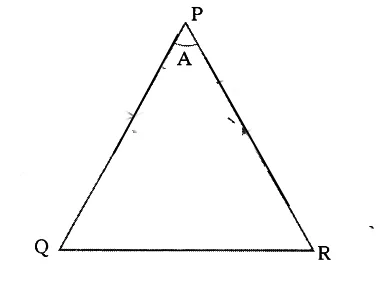Aim: To find the refractive index of a prism
Materials Required: Prism, piece of white chart of size 20 x 20 cm, pencil, pins, scale and protractor
Procedure:
1. Take a Prism and place it on the white chart in such a way that the triangular base of the prism is on the chart.
2. Draw a line around the prism boundary using a pencil.
3. Remove the prism
4. The shape of the outline is a triangle.
5. Name it vertices as P, Q and R.
Note: For many prisms the triangle formed is equilateral.
Angle of Prism
6. Find the angle between PQ and PR. This is the angle of the prism (A).

Angle of Incidence
7. Mark M on the side of triangle PQ and also draw a perpendicular to PQ at M.
8. Place the centre of the protractor at M and along the normal.
9. Mark an angle of 30 degrees and then draw a line up to M. This line denotes the incident ray. This angle is called the angle of incidence.
10. Note the angle of incidence in a table and Draw a small arrow on it as shown in the figure.

11. Place the prism in its position again.
12. Now fix two pins vertically on the line at points A and B as shown in the figure.

13. Look for the images of pins through the prism from the other side PR and fix another two pins at points C and D in such a way that all four pins appear to lie along the same straight line. Do it carefully.
14. Now again remove the prism and take out the pins. Draw a line joining the two pin-holes formed by the pins to meet surface ‘PR’. This is the emergent ray that emerges from the surface PR at point N.
15. The angle between the Normal at N and the emergent ray is the angle of emergence.
16. Measure this angle of emergence and note its value in the table.
Angle of Deviation
17. Now join the points M and N in a straight line. The line passing through A,B, M, N, C and D represents the path of light when it suffers refraction through the prism.
18. Extend both incident and emergent rays till they meet at point O . Measure the angle between these two rays. This is the angle of deviation. It is denoted by the letter ‘d’. Note it in the table.
19. Repeat this procedure for various angles of incidence like 40 degrees, 50 degrees etc. Find the corresponding angles of deviation and angles of emergence and note them in the table.
20. You will notice that the angle of deviation decreases first and increases with an increase in the angle of incidence.
21. Take the angle of incidence along the X-axis and the angle of deviation along the Y-axis. Using a suitable scale, mark points on graph paper for every pair of angles. Finally, join the points to obtain a smooth curve graph. Check your graph with the graph shown in the figure.

22. The refractive index of Prism can be found using the formula n =sin [(A+D)/2]/sin A/2
Suggested Projects:
- History Of Spherical Mirrors
- Corrosion of Iron
- Current Carrying Wires Produces Magnetic Fields
- Scientists who developed atomic theories
- Why do alcohols and glucose contain hydrogen but are not categorized as acids
- Experiment to Find Out Focal Length of a Lens
- Water of Crystallization Activity
- How do you select a good place to plant a tree?
This experiment has been taken from the class 10th Physics textbook

